Frozen water troughs make winter chores a pain- but even if you don’t have electric heaters, you can keep your livestock troughs thawed all winter. I’ll show you how!
When winter temperatures close in and temperatures drop, keeping horse troughs and water buckets from icing over can be a challenge. If your trough isn’t near an electrical outlet or you don’t have a bucket heater, ice may seem inevitable. But it’s not! In this article, I illustrate six ways to keep your horses’ water trough thawed without using a heater:
1. Partially Cover the Water’s Surface
The following section may contain affiliate links. As an Amazon Associate, we earn from qualifying purchases.
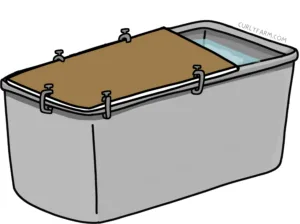
To prevent water from freezing in a trough, the first step is to cover as much of the surface of your tank as you can. Covering some of the water’s surface keeps heat in while still allowing horses access to water.
Consider using c-clamps (buy them on Amazon) to secure plywood or polystyrene foam insulation (buy it on Amazon) to partially cover the top of your trough. Troughs generally have a large surface area. Reducing the amount of water-surface in contact with cold air will slow freezing. Plywood secured over styrofoam panels is effective, inexpensive, and durable.
Improve the insulation even more by piling snow on top of the board covering the trough. The snow will provide extra insulation from heat loss.
2. Get Bigger Troughs
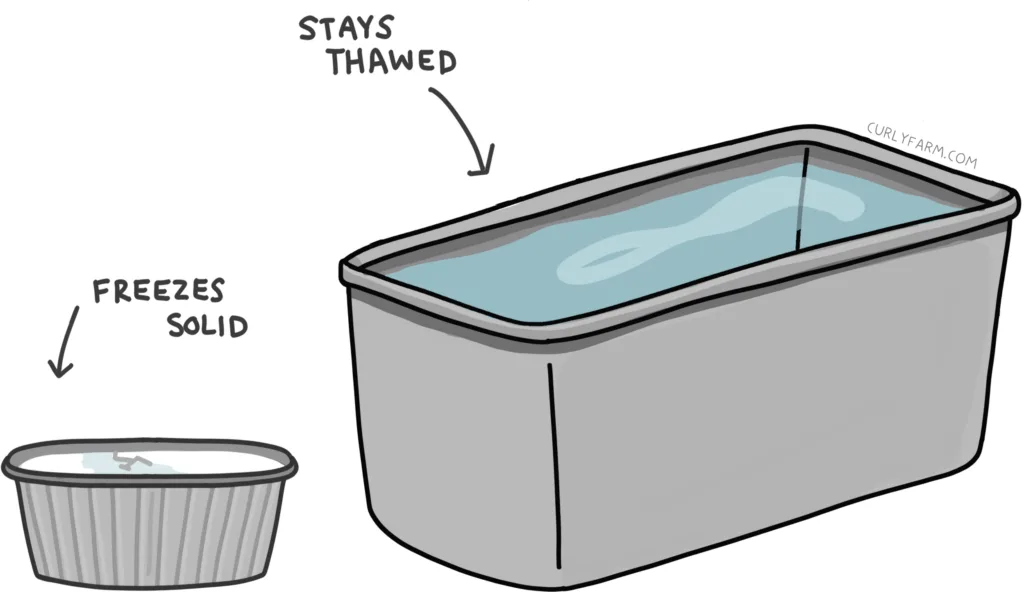
The bigger your horse’s trough, the longer it takes to freeze. A standard bucket of water freezes much faster than a 150-gallon tank. Covering some of the water’s surface keeps heat in while still allowing horses access to water.
When freezing temperatures are forecasted, fill your largest water tank(s) all the way to the brim. This helps to maximize the power of self-insulation.
3. Partially Bury Your Stock Tank (or Buckets)
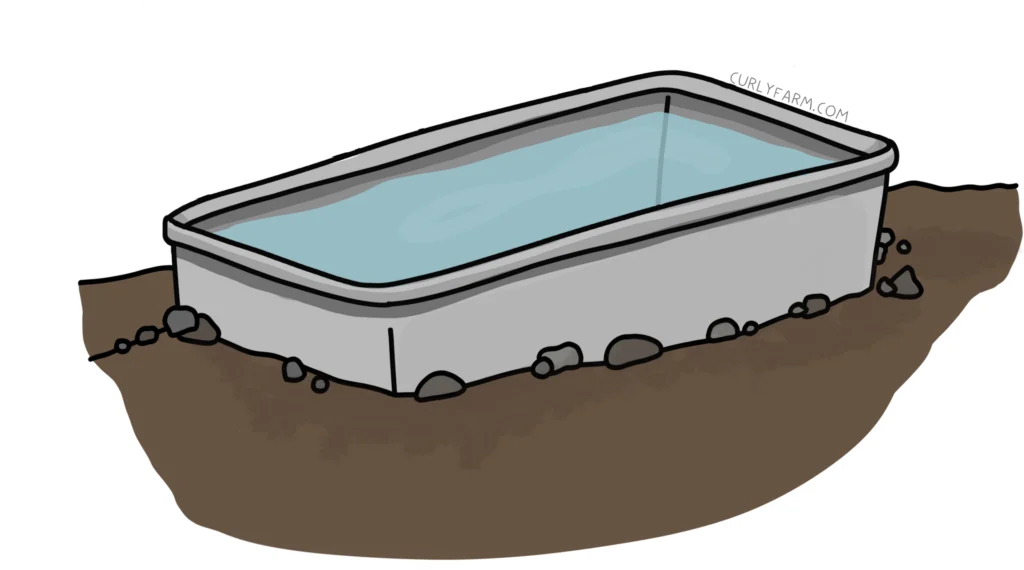
You can slow or prevent your trough from freezing in the winter by draining it, digging a shallow hole underneath, and re-placing the tank in the small hole. Pile the displaced dirt around the sides for insulation. This method is great for any farm with outdoor stock tanks. And can even be used with electric trough deicers, to reduce electricity use and improve efficiency.)
If it’s already mid-winter and the ground is frozen, try stacking a few bales of straw or waste-hay around 2 or 3 sides of the trough. Fill the gap between the bales and the outer sides of the trough with loose straw. (Just be sure the bales you use aren’t being nibbled by your horses- if the baling wire or twine comes loose, it can be hazardous) This extra insulation can help water stay thawed without electric water heaters.
4. Build a DIY Double-Walled Stock Tank
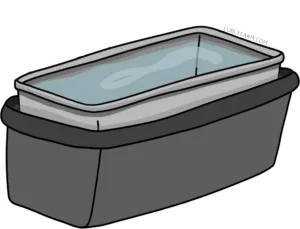
In the same way that a double-walled tumbler keeps drinks hot or cold, one of the most effective electricity-free ways to keep water from freezing is a DIY double-walled tank. Place one bucket inside of another to slow the escape of heat through the sides of the tank or bucket.
You can use this method with all sizes of buckets and troughs, from giant stock tank to 5-gallon bucket.
How to Keep Water Thawed using a DIY Double Walled Stock Tank
Total time: 20 minutes
First, source two buckets or stock tanks slightly different in size.
On our farm, old leaky stock tanks get saved for use as insulation.
Remove the plug from the larger trough (or drill a hole)
Water should be able to drain from the larger trough.
Place the smaller stock tank inside the larger stock tank.
If using buckets, place the smaller bucket inside of the larger one.
Fill the gap between the two troughs with insulation.
Next, insulate the space between the two troughs with whatever insulating material you can find (fiber or foam insulation works best, but dirt, straw, or hay chaff provide some insulation)
Estimated Cost: 20 USD
Supply:
- 2 bukets or stock tanks, one slightly larger than the other
Paired with a partial cover, this generally keeps a large tank from freezing over for a long period of freezing weather. Click here to read a longer tutorial on this trough insulation method.
5. Don’t Just Break Ice, Remove it
Water will stay thawed longer if you break up and remove ice chunks from the surface of your water. When winter chores include breaking ice in partially frozen water troughs and buckets, take time to scoop out the little icebergs.
Removing chunks of ice and then refilling the tank with water above-freezing will help extend the amount of time until the tank freezes over again.

5. Use Nature’s Heat: Manure!
In a pinch, harness the power of manure! During the worst of our electricity-outage-causing winter storms, we’d
- Fill a muck bucket with fresh manure.
- Put a water bucket on top of the manure, inside the muck bucket,
- Stuff straw in between the walls of the muck bucket and the bucket
It’s odd but it works! When we used this method during evening chores with overnight temperatures in the 20’s, the manure-insulated 5-gallon bucket remained ice-free overnight, while the 150-gallon tank had an inch of ice by morning. The picture below illustrates this method. The black muck bucket contained fresh manure, but the water in the blue bucket stayed clean- and warm! As long as the interior water trough is clean, the water won’t be contaminated.
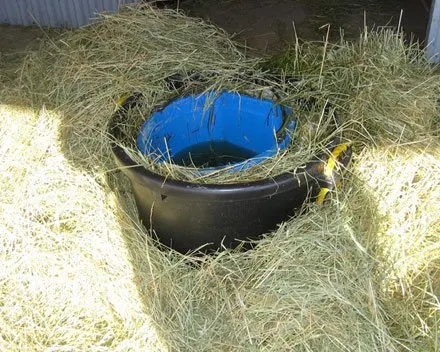
For a quick review, here’s a table showing the best ways to keep water troughs and livestock tanks thawed during freezing temperatures:
How to Keep Water Troughs Thawed without an Electric Heater:
| Method | How to | Supplies Needed |
|---|---|---|
| Cover Water Surface | Cover most of the surface with Styrofoam & plywood. Secure with clamps. Pile snow on top for extra insulation. | Styrofoam, Plywood, C-clamps |
| Bigger Troughs | Bigger troughs take longer to freeze. Fill large tanks to the brim to maximize self-insulation. | Replacement troughs |
| Partially Bury Stock Tank | Bury the trough in a shallow hole for insulation. Pile dirt and straw bales around the sides. | Shovel, Straw bales |
| 4. DIY Double-Walled Stock Tank | Place one bucket inside another, and insulate the space in between. | 2 stock tanks, Insulating material |
| 5. Remove Ice | Break up and remove ice chunks from the surface. | None |
| 6. Use Nature’s Heat: Manure | Fill a muck bucket with manure, place a water bucket on top, stuff straw in between the walls. | Muck bucket, Fresh manure, Straw |
More Winter Horse Care Tips:
In 2007, and again in 2008, massive ice storms hit Southwest Missouri, leaving trees and power lines covered in up to 2 inches of ice and cutting off electricity to rural areas for weeks. During those winters, nature forced us to learn a lot of tricks for winter horse care without electricity.
Today I’m going to share some electricity-less winter hacks with you. Whether you are preparing for disaster, reducing reliance on electricity on a homestead, making a DIY bucket heater, or just seeking ways to deal with unseasonably cold weather for your climate, keeping buckets thawed without electricity is possible. If you are without electricity (by disaster or by choice) these 6 methods to keep your horse’s water thawed in freezing temperatures without the use of a heater can help.
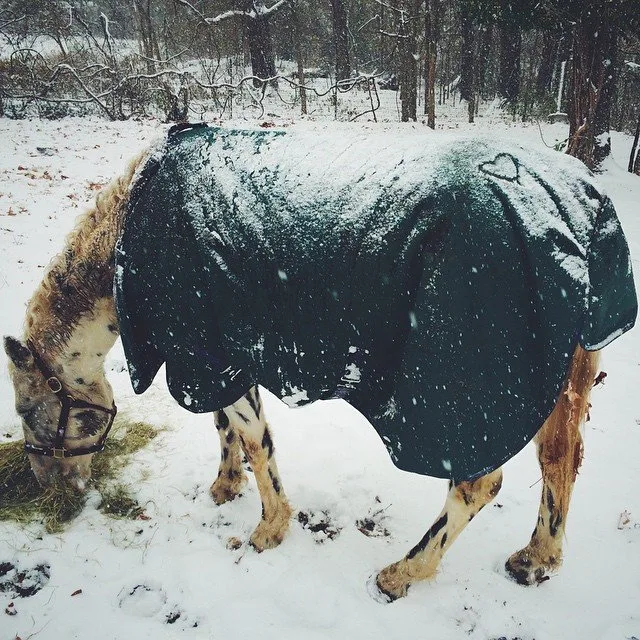
Carrying Water Buckets
If all else fails and your buckets and troughs freeze, don’t panic. As long as you have water in your home you’ll be able to water your horse by hauling water in buckets. Even in extreme winter weather, running buckets every hour or two from your home to your horse can help your horse stay healthy and hydrated.
Store Water Hoses Indoors in the Winter
It can feel like a lot of work to coil up a wet, cold hose after watering, but if the freezing temperatures are likely to outlast your water supply, you’ll need a plan.
To refill troughs with liquid water even in freezing temperatures, disconnect your hose and bring it inside after use. By storing your hose in a heated mudroom or laundry room, you’ll always have a flexible, above-freezing way to move water.
Plan for More Water than you Think You Need
Often, weather patterns that create freezing temperatures bring very dry air. This dry air can cause water in troughs and buckets to evaporate faster than it does during summer weather.
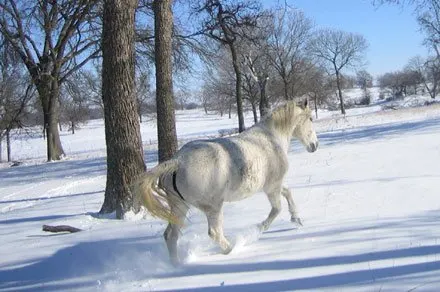
Remember, Horses are adapted to cold
Most horses know how to break through a layer of ice in a tank. If you have large troughs that are unlikely to freeze through, you may just need to keep an eye on the trough to check that the horses are breaking the ice as needed.
I’ve witnessed all of our horses breaking ice, but not all horses will know to try. (It seems to be partly instinct, and partly social learning from watching other horses during winter turnout.) Even in single digits temperatures, many horses will keep breaking ice through the night to keep a muzzle-sized hole open in the surface of the ice.
USe ELECTRICITY FOR KEEPING HORSE WATER THAWED:
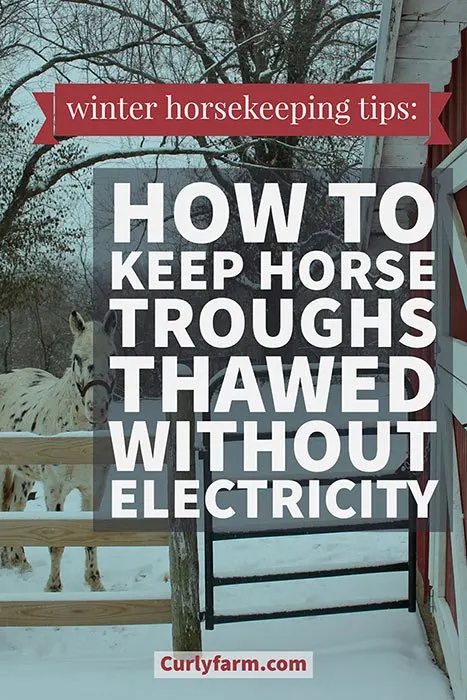
If your stock tank is near a fence or you have electricity running near the stalls in your barn, you can purchase heated buckets or heaters for stock tanks for a very affordable fee. These heaters are made for use in agricultural settings and are very tough and safe. Be sure to do your research or ask for help from a knowledgeable employee when shopping, though, as some heaters are not safe in some types of tanks
Conclusion
Electric heaters are an easy option that make winter horse chores easier- but bucket heaters and pond deicers aren’t always available.
Horse owners should always have a backup plan for how they will keep thawed water available for their horses in extreme winter conditions. Winter storms can cut electricity and sudden cold snaps can leave farms in temperate climates struggling for a solution to ice. If you have ice but no heater, these tips can keep water tanks thawed when you do not have access to an electric water heater.

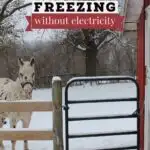
Henry
Tuesday 18th of October 2022
A fish tank aerator will work till it gets really cold.
Chester Noe
Tuesday 16th of February 2021
I had a frozen trough for the last couple days i havent been able to find a stock tank heater anywhere so i took a heat gun and a 30 inch piece of steel pipe to blow hot air into the tank it works as a hot air bubbler and is keeping it thawed in sub zero temps
Elsa Anderson
Thursday 5th of April 2018
My husband and I recently bought a small farm a few weeks ago and we are trying to figure out how to keep our water troughs clean and we are also worried about the troughs freezing in the winter. You mention that the bigger your vessel, the longer it will take to freeze. Also, a large volume of water will insulate itself and that makes a big difference in how long it stays thawed. The tip to partially bury your water troughs is great because it is something easy that my husband can do right away.
Brenda Paul
Thursday 23rd of February 2023
@Elsa Anderson, Keep in mind you will have to dump the water and clean the tub to refill with fresh water. We just break ice, however, we are in Tennessee and we don't have that many freezing days in a row.